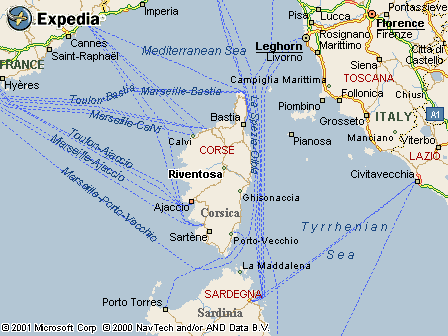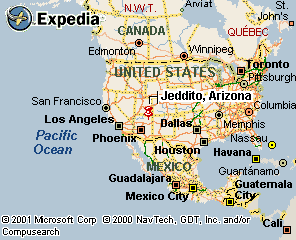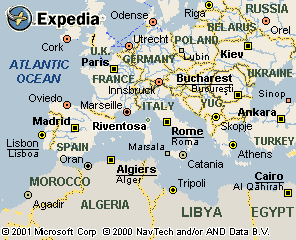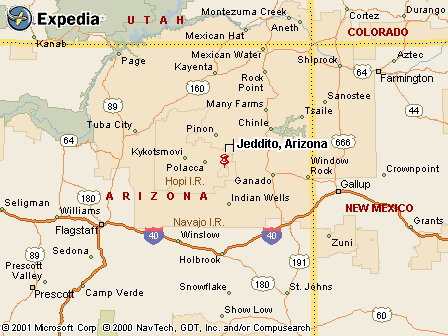|
|
Canku Ota |
|
|
(Many Paths) |
||
|
An Online Newsletter Celebrating Native America |
||
|
June 30, 2001 - Issue 39 |
||
|
|
||
|
Navajo Ways |
||
|
by Ollie Reed Jr. The Albuquerque Tribune - June 25, 2001 |
||
|
Photos by Stacia Spragg |
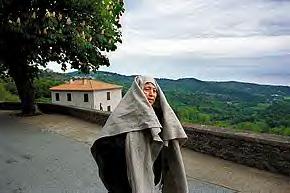 RIVENTOSA, Corsica -- Lena Benally, a Navajo shepherd and weaver, has her back to a corral filled
with sheep -- some white, some black, some tan, some gray, everyone of them bleating, blaring, noisy. RIVENTOSA, Corsica -- Lena Benally, a Navajo shepherd and weaver, has her back to a corral filled
with sheep -- some white, some black, some tan, some gray, everyone of them bleating, blaring, noisy.But Benally isn't listening to the sheep. She's listening to the wool. "It's saying: 'I'm OK. I am healthy,'" Benally interprets as she tugs on the fleece she's holding near her ear. "It sounds strong." Benally raises sheep at her home in Jeddito, Ariz., a remote place on the Navajo Reservation 60 miles west of Window Rock, a place of buttes, chasms, not enough water, too little vegetation and too much red dirt. But on this day last month, Benally is not at home. Nowhere close. She is instead nine time zones and thousands of miles away from Arizona, at shepherd Felix Battesti's corral in the central mountain region of Corsica, an island in the Mediterranean Sea. Benally and D.Y. Begay, another Arizona Navajo who raises sheep and weaves with wool, have come to Corsica to learn about Corsican shepherds and Corsican traditions and to tell Corsicans about Navajo sheep and Navajo ways. And at this very moment, with her back to the corral and the fleece to her ear, Benally is suffering from a jolt of culture shock. "It's too bad they throw this wool away," she says, dismay spelled out in the wrinkles of her brow. "Somebody needs to weave all this." Begay, 47, of Big Water and Red Streak Earth clans, is not only a full-time weaver but a curator of exhibits such as "The Voices of the Grandmothers," a definitive display of Navajo weaving that has traveled throughout the United States. She splits her time between a studio in Scottsdale, Ariz., and Tselani, Ariz., her family's home on the reservation. Begay has traveled throughout the United States and to Peru, Germany, Switzerland, Austria, England and Iceland but never before to Corsica. The two are part of an exchange program coordinated by Annette Samec-Luciani, a Corsican woman who lives in San Francisco. This week, Corsican shepherd and cheese maker Marie Ange Geronimi is taking part in the Sheep Is Life Celebration -- a program devoted to sheep, wool and weaving -- at Diné College in Tsaile, Ariz. Sheep Is Life is sponsored by Diné béiiná Inc., a community-based nonprofit organization of Navajo women. The Navajo, the United States' largest tribe, with a reservation spread out over parts of Arizona, New Mexico and Utah, have done as much as any people in the world to to nurture the art of weaving with wool. That's why Benally and Begay are staggered when they find out that Corsican shepherds shear their sheep to avoid matting and prevent disease but discard the wool. Just throw it away. The wool of the Corsican sheep, like the fleece of the Navajo's sacred Churro, is long, strong and low in oily lanolin, the best kind of wool for making fine, durable, colorful rugs and blankets. But there is no market for the Corsican wool because the weaving tradition has not survived with the same kind of vigor it enjoys on the Navajo Reservation. And although some knitting with wool is done, there is not enough of it to support all the island's shepherds. There was a time when wool was used to stuff mattresses but not now. 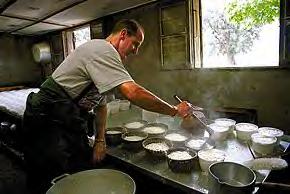 Now, Corsican shepherds keep sheep for their milk, which they turn into
cheeses such as the uniquely Corsican brocciu, which can be eaten salted, sweetened with sugar or with the brandy
Corsicans call aqua vitae (water of life). Now, Corsican shepherds keep sheep for their milk, which they turn into
cheeses such as the uniquely Corsican brocciu, which can be eaten salted, sweetened with sugar or with the brandy
Corsicans call aqua vitae (water of life).If Benally and Begay are surprised and disappointed to find that their Corsican counterparts throw away wool, the Corsicans are just as taken aback to discover that the Navajo use sheep for wool and meat but rarely make cheese from ewes' milk. Lots to tell. Lots to learn. It's likely most Americans know little about Corsica outside of the fact that Napoleon Bonaparte was born on the island. Before they looked it up, Benally and Begay did not know where Corsica was. It's nine miles north of the island of Sardinia and closer to northwestern Italy than it is to the French mainland. But it has been part of France -- with a few, brief interruptions -- since 1769, although the passionately nationalistic Corsicans object to calling it a French island and would never call themselves French. About 260,000 people live on Corsica, a small island just 115 miles from the northern most tip to the southern end and only about 55 miles from east to west. Rocky mountains -- dotted with lakes, pierced by rivers and smothered by a thick, fragrant brush called the maquis -- drop off to a ruggedly beautiful coastline blessed here and there with golden beaches and lapped at by water so blue a paint-by-numbers kit couldn't get it right. Corsica's water, more than anything else, awes Benally, who is hard put to shake the red dust of Jeddito out of her mind. "We should have all that water in Arizona," she marveled one morning while walking along a mountain road near the village of San Nicolao. San Nicolao is Benally and Begay's base of operations during their week in Corsica. They stay there with Samec-Luciani's parents, Antoine and Renee Luciani, whose house dates back to the 1300s. Villagers young and old teamed up in Salicetu, Corsica, on a Saturday afternoon to show Benally and Begay the ins and outs of the all-but-lost art of making rope from goat hair. About 24 feet of goat-hair rope is needed to pack a donkey properly. San Nicolao is a village of tall stone buildings with roofs of gray, slate shingles or red, clay tiles. Groves of orange, grapefruit, lemon and cherry trees are draped along the hillside below the village. 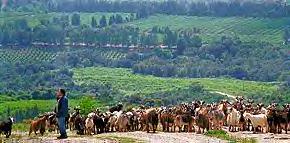 Above it, the hills are alive with purple wildflowers, wild orchids,
trees tenacious enough to grow out of blue stone cliffs and with herds of goats. Above it, the hills are alive with purple wildflowers, wild orchids,
trees tenacious enough to grow out of blue stone cliffs and with herds of goats.And everywhere around San Nicolao there is water -- the seemingly endless Mediterranean stretching out to the east, rivers, streams and waterfalls. Even when you can't see the water, you can hear it. "The water never dries," Benally said, shaking her head as she talked. "It's amazing. Really amazing." Despite the obvious difference between arid Arizona and verdant Corsica, Benally and Begay find the Navajo have a lot in common with the people of the island. Both retain a fierce sense of independence and identity despite subjugation by more powerful cultures. The Corsicans remember the May 8, 1769, Battle of Ponte Novo, a crushing defeat of Corsican troops by the French, with the same mixture of reverence and remorse that the Navajo reserve for the Long Walk, the forced march of Navajos to confinement after the U.S. Army defeated them in 1864. The two weavers learn young people leave Corsica to find work just as young Navajos leave the reservation to find jobs or get an education. About 60,000 of the 260,000 people living on Corsica are 60 years old and older. "When you are Corsican," said Claude Robertson Forcioli, who served as Benally and Begay's interpreter during part of their stay, "you spend a little time in a lot of places. And then you come back to Corsica." Both the Navajo and the Corsicans have clung to their native languages despite the efforts of dominant cultures to suppress the mother tongue and assimilate the people. French is the official language on Corsica. Only now is Corsican, which sounds more like Italian than French, beginning to be taught in schools. Begay told the Corsicans how Navajos such as herself, who attended boarding schools in the 1960s and '70s, were not allowed to speak Navajo -- but did anyway. "My father says when you stop speaking the language is when you stop being Navajo," she said. "Ya'at'eeh." Young voices squeal the traditional Navajo greeting in unison as Benally and Begay walk into the small school in the village of Piedicorte. Guided by their principal and only teacher, Genevieve Biancardini-Dumas, the school's 10 children, ages 4 to 11, have been studying Navajo culture for weeks in eager anticipation of the Navajo women's visit. 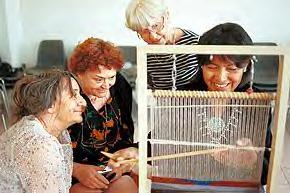 Crayon drawings on the classroom wall testify in vivid hues to the fact
that the children have made progress. The earliest efforts depicted Navajos in war bonnets hunting in forests or
on the plains. The most recent ones still have too many feathers, but the high desert landscapes of mesas and canyons
are dead on. Crayon drawings on the classroom wall testify in vivid hues to the fact
that the children have made progress. The earliest efforts depicted Navajos in war bonnets hunting in forests or
on the plains. The most recent ones still have too many feathers, but the high desert landscapes of mesas and canyons
are dead on.They're still learning. A little girl asks Benally and Begay if the Navajo live in fur tents. "Not the Navajo," Begay said. "We live in houses -- six- or eight-sided houses called hogans. The very old ones are made out of dirt." When that's interpreted, looks on the faces of some children suggest that they think fur tents might be better. Begay tells the children that the Navajo don't like to call themselves Navajo. "That name was given to us by the Spanish, and it means 'people who take things,'" she said. "It's derogatory. We call ourselves 'Diné,' which means 'The People.'" The people of Corsica, especially those devoted to preserving traditional ways of life, are what Benally and Begay's journey was all about. They visit as varied a group as possible. They share a lunch of cheese, ham and wine on a hillside with shepherd Paul Griscelli, who lives so high up in the mountains that the name of his village, Petra Bianca, or white stone, comes from the fact that snow covers the ground much of the year. In the village of Croce, they meet Willy Fourmy, who practices the almost extinct art of making pack saddles for mules and donkeys. Fourmy tells them the dimensions he uses in making the saddles have changed in recent years because animals, like humans, don't work as hard as they once did so their backsides are bigger than they used to be. The women tell Fourmy they use pickup trucks instead of pack animals. They drop in on basket maker Antoine Bastiani at his home not far from Croce. And, on a sunny, sleepy Saturday afternoon, they go to the tiny village of Salicetu to meet with the several women who make up Lana Corsa, a small company that uses the wool of the Corsican sheep to knit and -- more rarely -- weave sweaters, scarves and other products. It is in Salicetu that Benally and Begay get a lesson in making rope out of goat hair, a craft not much practiced in the village now. The demonstration turns into entertainment as old people settle down on chairs and benches to enjoy the slapstick spectacle of villagers, who have nearly forgotten how, showing Americans the way to braid rope. Benally and Begay stop at a farm near the town of Corte to see Joseph and Pierre Jean Orsatelli, brothers who keep and milk 500 sheep and turn out 90 cheeses a day, cheeses made by hand in a stone house with the windows open so that the brocciu is cooled by the breezes. The Orsatellis have made some concessions to modern times and regulations. They milk their sheep with machines. They make the cheese on a stainless steel table and mold it in plastic baskets rather than in the traditional wicker baskets. But France's membership in the European Union means more economic and sanitary regulations more strictly enforced, and so the Orsatellis are looking at replacing their cool, stone house with new facilities and new equipment. They must change the way they have done things for generations or stop doing it. Shepherd Marie Ange Geronimi, a friend of the Orsatelli brothers, shakes her head in empathy. "We have been making cheese this way for years," she said, "and no one ever gets sick." Benally and Begay understand. They have watched the 20th century -- and now the 21st -- chew away at their culture, making laws, changing boundaries, seducing their children away from the life of their ancestors. Like the Navajo, Corsicans have hung onto to their traditions and freedoms as stubbornly as possible. Until 10 years ago, fences were not common on the island. "We cannot let the animals free like in the old times," shepherd Felix Battesti said. "People used to think and live differently. When I was 13, I was maintaining my garden. I had my donkey. That was my life. "Now, we have cars and big grocery stores. Sure, we need them. But, still, I wonder if it was not better in the old times. Wasn't it better, this simple life, with no complications, no stress or depression? We were not asking ourselves questions. We were just busy living." When she found out she was going to Corsica, Benally worried that she would lose her direction so far away from her homeland. But Benally's mother, Mary, told her not to worry. If that happened, she should just find an anthill and lie beside it. "She told me that ants were always busy, walking in the same direction, in a line," Benally said. "She said ants never lose their direction. She said the ants would give me my direction." Sometimes, Benally did feel lost in Corsica. She missed her family -- and the eggs and potatoes she eats at home. "They don't use eggs here or chickens." She found Corsican money confusing. "They don't have something simple -- like 99 cents." And she never really got comfortable with being kissed on both cheeks, a traditional Corsican greeting. "There's a whole lot of pecking going on here," she said. "At home, we just shake hands." But at Battesti's corral, on a hill dotted with cork oak trees and white-blossomed asphodel plants, Benally discovers something she has always known deep inside. It is sheep, not ants, that give her direction." "This is like home," she said. Begay agrees. "Even though there is a great distance between us, we make a connection through the sheep," Begay said. "Both the Corsican shepherds and the Navajo shepherds have a common concept of living off the land and living from season to season. And both take great pride in taking care of the sheep. "Here, we feel at home." |
|
|
|
|
|
|
|
D.Y. Begay-The Navajo Rug Weaver |
|
|
||
|
|
||
| Canku Ota is a free Newsletter celebrating Native America, its traditions and accomplishments . We do not provide subscriber or visitor names to anyone. Some articles presented in Canku Ota may contain copyright material. We have received appropriate permissions for republishing any articles. Material appearing here is distributed without profit or monetary gain to those who have expressed an interest. This is in accordance with Title 17 U.S.C. section 107. | ||
|
Canku Ota is a copyright © 2000, 2001 of Vicki Lockard and Paul Barry. |
||
|
|
|
|
|
The "Canku Ota - A Newsletter Celebrating Native America" web site and its design is the |
||
|
Copyright © 1999, 2000, 2001 of Paul C. Barry. |
||
|
All Rights Reserved. |

